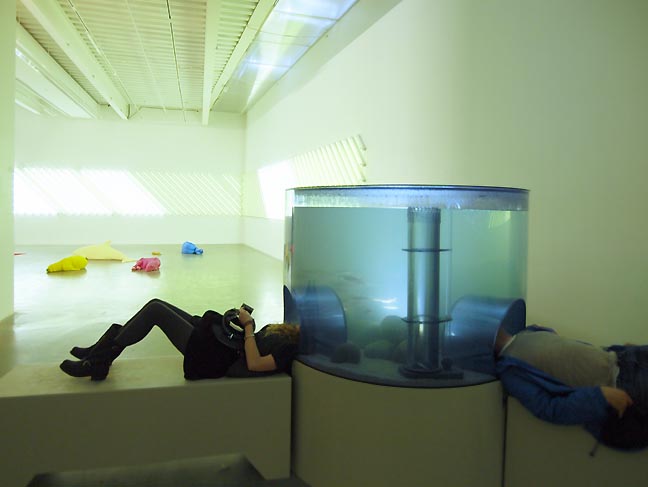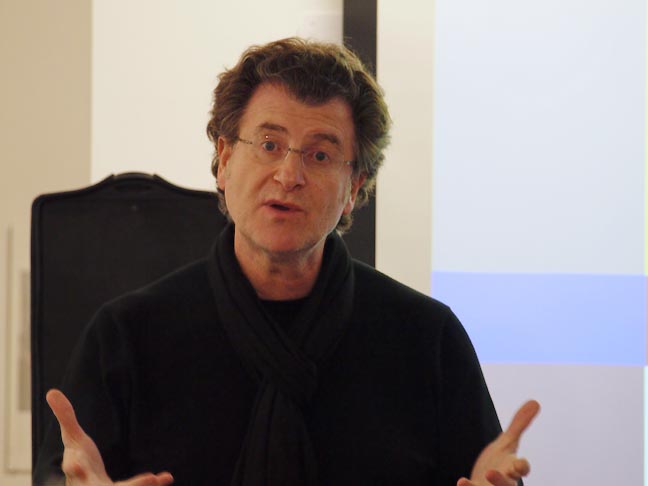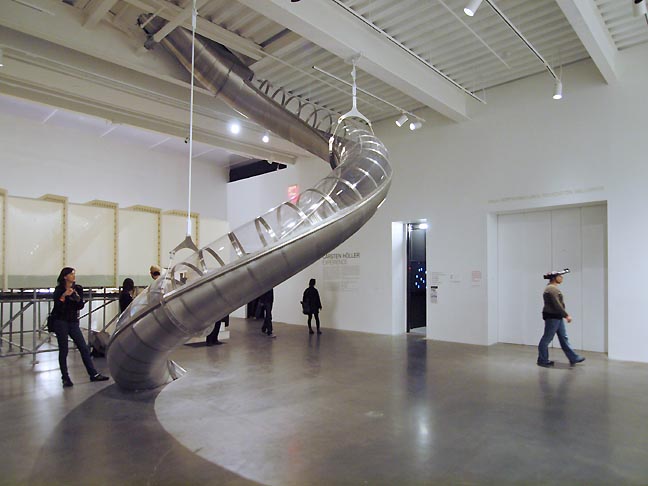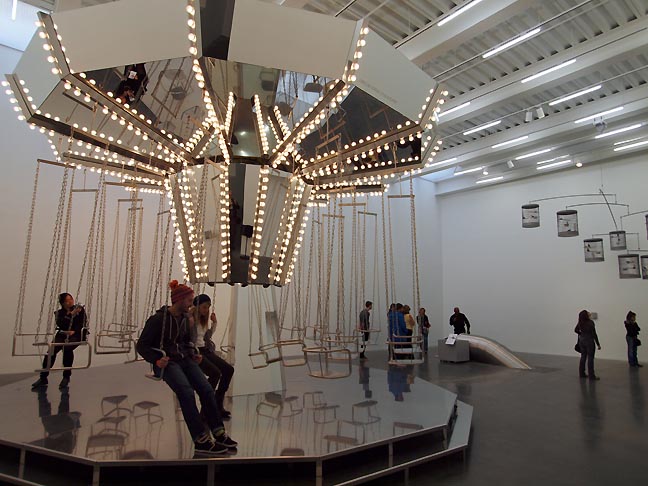
|
||
|
Portland art blog + news + exhibition reviews + galleries + contemporary northwest art
|
||
Alfredo Jaar and Carsten Holler  Carsten Holler's Double Light Corner (2011), Animal Group (2011) and Aquarium (1996) at the New Museum (photo Jeff Jahn) It isn't often that I write about programmatic archetypal curatorial strategies used in art exhibitions but two recent experiences; visiting Carsten Holler's Experience retrospective at the New Museum and Alfredo Jaar's talk "It is Difficult" sponsored by OCAC raise questions about the role of the artist and institution as well as how they ultimately interface with their viewers. 
Alfredo Jaar speaking in Portland October 14th (photo Jeff Jahn) Though Holler and Jaar couldn't be more different, both highlight the way the art experience is attenuated by how the artist/institution divide is negotiated (Jaar is very selective and insists on carte blanche). True, all art exhibitions represent a kind of experience but some are intended primarily as such and I'd like to discuss this "experiential" form which usually involves altering the perceptions of reality and is less object or conceptually focused than it is kinesthetic/perceptually engaging. It is telling that experiential work frequently requires a certain presentness of the viewer to fully respond. That response is so crucial that it is common for experiential shows to turn viewers into performers of sorts. As a kind of stagecraft, the specific theatricality of this kind of art deserves more sustained attention. For instance, I like to think of these experiential shows as belonging to two groups: "Rides" and "Shrines". Both types are outside the normal experience. Great examples of shrines would be Walter di Maria's earth room, Judd's artillery sheds or any classic Robert Irwin piece, even Ai Weiwei's immense room of "Sunflower Seeds" at Tate Modern. Ride shows became popular in the second half of the Twentieth Century with examples such as, Let's Entertain (which made a stop in Portland back in 2000) or Ecstasy at MOCA in 2005. For the ride precedents there are the very sparse/clinical 1960-70's shows by Dan Graham and Bruce Nauman both found a way to turn the empirical inquiry into spectacle. Today, artists like Olafur Eliasson and Carsten Holler are perhaps their heirs as both use some science and viewer participation to complete their works, but the difference is how much more inviting Eliasson and Holler are. Ultimately a "Ride" show is one which acknowledges the viewer to the point of pandering to them (in attempts to get them to activate the piece)... a Shrine exists stoically outside the viewer and both strategies have their place. To complicate categorical matters, an artist like Jason Rhoades routinely created installations that belonged in both categories as a kind of profaned shrine and stoic carnival, Thomas Hirshhorn belongs to this same category but to a lesser extent since he leans more towards a Barumesque/carnival-style management of the viewer's path. I'd consider Bruce Nauman's Mapping The Studio I (Fat Chance John Cage) to be a shrine... it is spare and takes nearly 6 hours to watch in it's entirety... that's simply too demanding to be considered a ride so the attention span required of the viewer is a major component in how I'm sorting the two categories. Obviously, an example like Matisse's Vence Chapel is quite literally a shrine. Whereas, Matthew Barney, though his presentation of film props creates a recurring spectacle related to and I'd argue subordinate to his films... a carnival of promotional proportions? Whereas Mike Kelly's A Voyage of Growth and Discovery somewhat mocked Burning Man, the planet's penultimate carnival.... a shrine as a critique of a carnival? It may seem complicated but the difference really is not, a ride more often than not takes a short time and has an obvious beginning and end (like Carsten Holler's slide pieces) whereas shrines have an infinite or at least seem to cultivate a sense of vastness in the viewer. For background, theorists like Mikhail Bahktin felt the carnival atmosphere was liberating and empowering environment for the lower classes. Other theorists like Guy Debord also focused a great deal on spectacle and presented the idea that such public displays both highlighted and removed pain. Within the last decade though glitzy group shows like Let's Entertain (2000) wore their essentially carnivalisque atmosphere on their sleeves as have other group shows like Beau Monde Site (Santa Fe 2001), Disparities and Deformations Our Grotesque (Site Santa Fe 2004) or most any Whitney Biennial. Practically any giant survey show or festival takes on a carnivalesque aspect. The interesting part is how the gap between the haves and have nots and recently widening fractures have made some museum shows seem diversionary rather than realms of empowerment. In the case of Maurizio Cattelan's case his current retrospective/spectacle at the Guggenheim looked for all the world to be an artist who once had an edge as a court jester but had suddenly become the favorite pet of the rich, and given his own monument. The effect is chilling, a collection of jokes gone stale. It is never good when the joker is given too much of the king's treatment. In Holler's case his retrospective at the New Museum is essentially a series of rides (some quite literally)... and not dissimilar to Olafur Eliasson's recent Your Art retrospective. Both are more related to Dan Graham's very clinical "ride" shows rather than Robert Irwin's infinitely more stoic offerings.  Carsten Holler's Untitled (Slide), Giant Psycho Tank and Upside- Down goggles at New Museum At the NuMu Holler has cut through the floors of the museum and installed a slide, giant mushrooms, a mirrored carousel and for irony's sake a bunch of caged birds. Other more internal rides like Pill Clock literally produce a timed release within the body by asking viewers to take a pill. It is an interesting reversal of Carsten's slide ride. Overall, Holler's former background as a scientist presents him as as an artistic engineer of experiments upon which the viewer becomes the subject and the institution becomes a kind of laboratory The bigger question is to what end? Some of the experiences are a little too novelty driven to be considered experiments... the slide for example. Whereas, the Infrared Room reminds me a lot of Dan Graham's surveillance works of the 60's and 70's except that Holler is trying to alter consciousness rather than test consciousness. To that end viewers can survey the entire Holler show fitted with upside down goggles. All of it is essentially novel stimulus of varying degrees and because it is a bit of a carnival there are numerous options to choose from. Perhaps it is the fragmented series of rides that separates it from a shrine situation... instead of concentration on one option the exhibition constitutes a panoply of choices. Yet here the institution and artist make the viewer complicit in a narcissistic need to be part of the show and gratified through an altered experience that seems set forth just for them. One could characterize it as engaging the viewer but it could just as easily be pandering to them.  Holler's Mirror Carousel (2005), Untitled (slide,) Singing Canaries Mobile (2009) It is a fine line but Holler's show left me feeling conflicted in the "difficult to care much" way. Sure, sliding through the museum is novel but instead of an institutional critique it seems to say, if you have the reputation you can make new rules. In this case the new rules feel arbitrary and don't seem to have much relationship to the world outside. Is novelty in itself a justification worth pursuing? In such tense times I wonder if the 99% find any solace in Holler's gee whiz intervention? Maybe it isn't fair to ask if Holler's mirrored carousel engages crises in Egypt, Greece and Italy but it certainly doesn't highlight introspective self appraisal as much as it says, look what I can do. It seems like poor timing and hits the wrong notes. This ambivalence came to a head with Holler's Singing Canaries Mobile (2009). In that post bank bailout work the caged birds sing in the same ways visitors to this show explore the museum as it is laid out for them... whereas Holler's "High Rise Sculpture" (2006) looks like an expensive game of chutes and ladders that parallel the way Wall Street always seems to have escape routes that aren't available to everyone. Should I give Holler credit for being prophetic or is it just complicit? Obviously this isn't Holler's fault, he's been doing this kind of art since 1993 and his experiments can't be seen as directly related to the current economic situation... still, like Cattelan (the court Jester) Holler and Eliasson (as court magicians) might not enjoy the same popularity their shows have previously enjoyed before 2011-2012. Are the museums just trying to draw greater attendance... you betcha. There is something about so many of Holler's diversions all in one place that make him seem complicit with the money that made this possible, a mere court magician? I'd never accuse Bruce Nauman or Dan Graham of that. Im not suggesting that having or using money is wrong, simply that an artist like Nauman is too rigorous and somehow demanding to be seen as working the system. Nauman destroyed systems. 
Alfredo Jaar's Skoghall Konsthall (2000) Which couldn't be more different than Alfredo Jaar who spoke in Portland on November 14 just after the Occupy Portlanders had been given an eviction notice yet not evicted. Though his work is resolutely secular Jaar creates shrines to concise bits of information that surround complex ideas and historical realities. Think of him as a designer that respectfully briefs his patrons and viewers then leaves them to interrogate themselves. Essentially Jaar is a designer that creates shrines to information and generally demand one's complete attention. Thus his work presents a different kind of empowerment not found in rides or carnivalesque situations... the power to focus attention, which is something the Holler show (or anything similar) tends to splinter as a form of entertainment. During Jaar's talk he discussed his public works and each of them; One Million Finnish Passports, Skoghall Konsthall, memorial for Chile and his Rwanda series, showed him to be a respectful presenter of information with a verve for restrained theatricality. One project Jaar discussed at length was Dear Markus. In Spring 2010 during a research trip to Finland Jaar waited for a ferry to take him on the 4 hour trip back from the furthest of the archipelago islands he was investigating for the project. Jaar was curious why the boat was leaving at 5:45am. He was flabbergasted that it was because a boy living on a small island on the route has to get to school. Jaar's work then developed into a series of bill boards with messages for Markus from Finnish thinkers on the islands as well as a book. I was intrigued how Jaar used a young man's life to highlight a larger social policy towards education... a ride in Markus' boat that highlighted the eccentricities and existential situation. The poetry of it was elegant and rational in its air of absurdity. Obviously children and education matter in Finland. Earlier in his career Jaar had cast a more critical net with his 1 million Finnish Passports project where the artist calculated Finland's closed emigration policy had kept 1 million people from entering the country. Besides his Rwanda project which you should just check out the project that resonated the most with me was his Skoghall Konsthall project. In a paper mill town without a contemporary museum he created one out of timber and paper and filled it with exhibitions. 24 hours later it was intentionally burnt and a town that previously had no real interest in having a contemporary art museum suddenly wanted one, which Jaar later agreed to design (Jaar is an architect as well). It was a masterstroke of design to get at the essence of the problem... that the population wasn't that interested in contemporary art and by doing so an answer arose. Yes, by ritually creating then burning an art museum Jaar created a ride of sorts but it's intensity created a shrine to the destroyed structure. This was powerful stuff and couldn’t be more different than Cartsen Holler who basically tricked out an existing museum to reveal a novel way of traversing the plan. The difference is Jaar's approach seems to have greater risks and rewards. Holler suspends reality, Jaar hones in on the essence of difficult to describe situations and prompts the viewer to process the information. Thus to be dialogical... Holler's show is in the business of processing visitors through a series of experiences that have be designed to make the museum experience more novel, whereas Jaar is interested in a very clean cut form of theatrical education and in many ways seems to pander only to the innate human need for more information. Will these somewhat lightweight but entertaining one artist ride shows like Holler's continue to be popular with major museums?... or will experiential artists interested in the profound like Jaar ultimately be engaged to remake the museum experience which has increasingly become entertainment driven? It is interesting that Jaar does a lot of his most interesting work outside of an established museum. Let's just say I prefer it when museums take a more serious route and I hope Jaar will do a project in Portland some time... or at least shows his fantastic The Sound of Silence at PAM or Bluesky some day. It is one of the best pieces I have ever encountered and though it is a ride (it micro manages the viewers) in the end, like all of Jaar's work, it creates a kind of shrine to the the information it shares. Yes carnival style shows are here to stay but they actually work better as unwieldy group shows, rather than neatly fitting into museum as entertainment venue. When a single artist becomes the carnival it better be truly subversive like Paul McCarthy or Jason Rhoades... so that it feels like the show is testing the institution's boundaries not simply making the museum more novel. I can say that Jaar's presentation was probably the best Portland visual art talk in 2011, outclassing everything else... and that dear readers is an experience to have. Posted by Jeff Jahn on November 29, 2011 at 14:47 | Comments (0) Comments Post a comment Thanks for signing in, . Now you can comment. (sign out)
(If you haven't left a comment here before, you may need to be approved by
the site owner before your comment will appear. Until then, it won't appear
on the entry. Thanks for waiting.)
|
| s p o n s o r s |
 |
 |
 |
 |
 |
 |
 |
 |
 |
 |
 |
 |
 |
 |
 |
 |

|
Site Design: Jennifer Armbrust | • | Site Development: Philippe Blanc & Katherine Bovee | |

